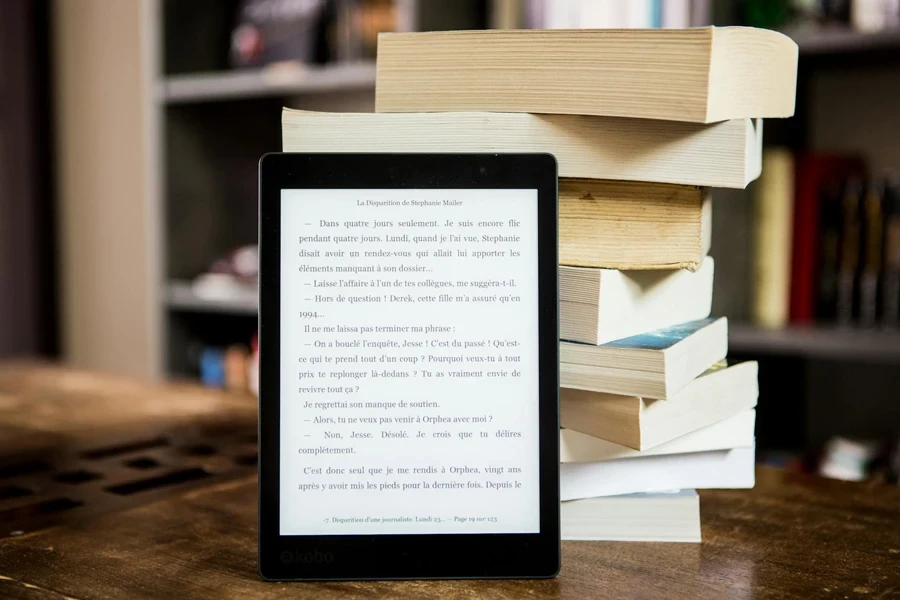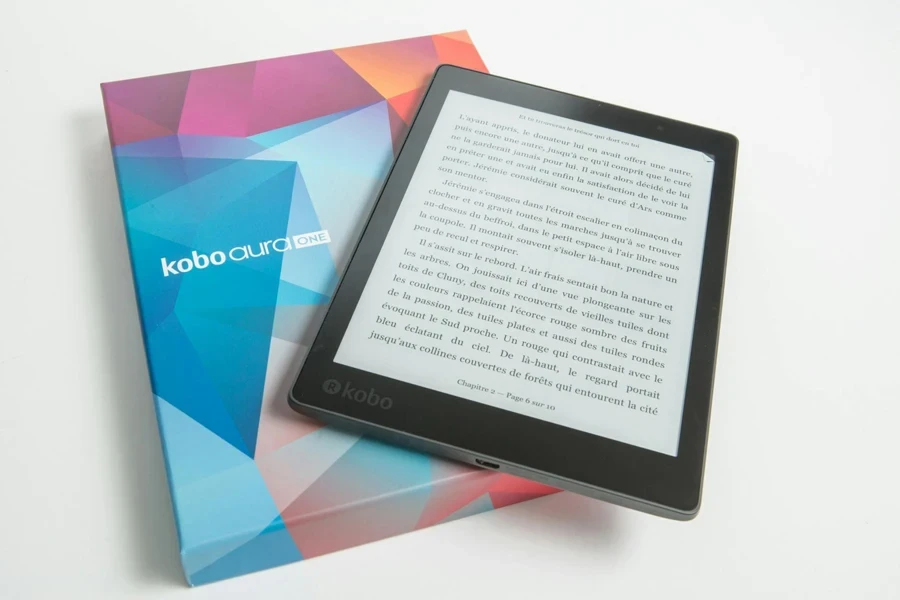Table of Contents
● Introduction
● Market overview
● Things to consider when selecting e-books
● Best products/models/types and their features
● Conclusion
Introduction
Electronic books have swiftly transitioned from niche novelties to mainstream essentials in the consumer electronics arena, mirroring the rapid digital transformation of our society. This shift not only reflects changes in consumer preferences but also marks significant advancements in digital technology and accessibility. E-books offer unparalleled convenience and a reduced environmental impact, catering to a society that values sustainability and instant access to information. They are increasingly important in educational contexts, where digital textbooks and resources can greatly enhance learning experiences and accessibility. As the market continues to evolve, understanding the factors that influence e-book adoption and usage becomes crucial for both consumers and industry stakeholders.

Market overview
The global electronic books market is poised for continued growth, with projections indicating a market volume of approximately US$15.33 billion by the year 2027, according to Statista. This represents a compound annual growth rate (CAGR) of 1.62% from 2024 to 2027. In 2024 alone, the market is expected to generate significant revenue totaling US$14.61 billion. This growth is primarily driven by the increasing adoption of e-books across various demographic segments, attributable to the convenience and accessibility that digital formats offer over traditional print media. Moreover, the United States is forecasted to lead this market, contributing the highest revenue figures, which underscores the substantial impact and leadership of the U.S. in the global e-books industry. This trend is further supported by an expected rise in e-book readership numbers, projected to reach 1.1 billion users by 2027. The user penetration rate, which measures the percentage of potential consumers who purchase e-books, is also anticipated to increase from 13.3% in 2024 to 14.1% by 2027. These figures suggest a growing consumer shift towards digital reading, fueled by technological advancements and the widespread availability of reading devices and platforms that support e-books.
Furthermore, the economic dynamics of the e-book market reveal a promising outlook. The average revenue per user (ARPU) is projected to hit US$14.18, according to Statista, indicating a robust expenditure per consumer on digital reading materials. This level of spending reflects the value consumers place on the convenience and enhanced features offered by electronic books, such as instant access, portability, and the ability to customize reading experiences with adjustable text sizes and integrated dictionaries. This shift is not just limited to consumer convenience but also represents a broader transition in how media is consumed in the digital age. Statistically, the growing numbers reflect an ongoing cultural shift towards digital media consumption, which is progressively becoming embedded in everyday life. These market trends not only highlight the economic viability of the e-books sector but also underscore its significance in driving future trends in publishing, content consumption, and technological integration in the media industry. As e-books continue to evolve, they are expected to play a pivotal role in shaping the future landscape of education, entertainment, and information dissemination.
Things to consider when selecting e-books
Interface and compatibility
When selecting an electronic book reader, the user interface and compatibility with various formats are crucial. A well-designed interface enhances user interaction by making navigation, downloading, and reading effortless and intuitive. This should include features like easily accessible menus, straightforward library management, and quick response times. Additionally, the ability to customize reading experiences, such as adjusting font size, style, and background color, caters to personal preferences and can make digital reading more accessible for those with visual impairments. Compatibility is equally important, as supporting a wide range of file formats ensures that users can access their preferred content from various sources. This flexibility allows users to read everything from classic literature to modern research papers, thus broadening the e-reader’s appeal across different reader demographics.

Content availability and acquisition
The value of an e-book reader is largely determined by the breadth and accessibility of its content. Platforms that offer a vast selection of e-books, magazines, and academic papers attract a wider audience by catering to diverse reading interests. Ease of purchase and download is another critical factor; platforms that facilitate a smooth transaction from selection to reading — preferably with few clicks and minimal loading time — enhance user satisfaction. Subscription services or integration with public libraries can further expand access to content, providing unlimited reading material for a monthly fee or free access with a library membership. Such features not only make reading more affordable but also encourage the exploration of new genres and authors, enriching the digital reading experience.
Technical features
The technical specifications of e-book readers can significantly impact the overall user experience. Devices with long battery life are highly valued as they allow readers to use their devices for several days on a single charge, ideal for travel or extended reading sessions. The type of display technology also plays a vital role; E-Ink displays mimic the appearance of actual paper and provide a glare-free reading experience that is easier on the eyes, making them perfect for avid readers. Conversely, LCD screens are better suited for interactive and multimedia content, displaying vibrant colors and detailed images that enhance graphic novels or educational materials. Storage capacity is another consideration; devices with expandable storage offer the flexibility to carry extensive e-book collections, making it possible for users to have access to their entire library anytime, anywhere.
Support and updates
Continuous manufacturer support and firmware updates are essential for the longevity and functionality of e-book readers. Effective customer support can significantly enhance user satisfaction, providing quick solutions to operational issues and advice on maximizing device potential. Firmware updates play a critical role in maintaining device security, adding new features, and improving existing functionalities, which can extend the product’s life and adapt its capabilities to evolving user needs. Regular updates ensure that the device remains compatible with new e-book formats and security protocols, safeguarding user data and enhancing the device’s usability over time. These services are crucial for keeping the device relevant and functional in a rapidly evolving digital landscape.
Price vs. performance analysis
Determining the balance between cost and performance is crucial when investing in an e-book reader. Higher-priced models often offer advanced features such as waterproofing, audio playback capabilities, and integration with other digital services, which may be superfluous for users primarily interested in basic reading functions. Evaluating the essential features against their use cases allows consumers to make cost-effective decisions. For example, a casual reader might opt for a basic model that delivers an excellent reading experience without additional frills, while a tech-savvy user might look for a device with connectivity options and multimedia support. By closely analyzing how each feature aligns with personal reading habits and technology usage, consumers can choose an e-reader that offers the best value for their specific needs.
Best products and their features
Overview of leading e-reader devices
In the e-reader market, devices are crafted to suit a wide range of consumer needs, spanning from basic models focused on delivering a paper-like reading experience to advanced devices featuring extensive multimedia functionalities. These e-readers come from several leading manufacturers who prioritize different aspects of user experience, such as battery life, weight, and ease of use, to appeal to various consumer segments. Basic e-readers appeal to traditionalists who enjoy the tactile feel of books but want the convenience of carrying multiple titles in one device. More sophisticated models offer backlit screens, adjustable text features, and even waterproof bodies, catering to users who read in various environments, including outdoors or while traveling. The choice in the market allows users to select a device that best fits their reading habits and lifestyle needs, whether they prioritize long battery life for uninterrupted reading or a lightweight design for easy portability.

Comparative analysis of screen technology and connectivity
Screen technology plays a critical role in the selection of e-readers, with E-Ink screens being popular among avid readers due to their paper-like display that does not cause eye strain even after extended reading sessions. E-Ink displays offer superior readability in bright sunlight compared to LCD screens, making them ideal for readers who enjoy reading outdoors. However, LCD screens attract users interested in color-rich content like magazines, children’s books, or graphic novels, where vibrant color reproduction is crucial. On the connectivity front, modern e-readers generally include Wi-Fi, with some models offering optional cellular connectivity to download content anywhere without needing Wi-Fi. This feature is particularly beneficial for readers who travel frequently or live in areas with limited internet access. Enhanced connectivity options ensure that users can easily access new books and download them to their devices at their convenience, keeping their library up-to-date and varied.
Specialized e-readers for tech-savvy users and educational content
Specialized e-readers designed for tech-savvy users and educational purposes are equipped with features that enhance functionality beyond basic reading. These devices often include tools for note-taking, highlight options, and the ability to make annotations directly onto the text, which are invaluable for students and professionals. Educational e-readers may integrate with platforms that distribute educational content, making it easier for students to access textbooks and learning materials digitally. Such integration often extends to collaborative features, allowing users to share notes or discuss texts directly through the device. This makes these specialized e-readers not only a tool for reading but also a comprehensive educational resource that supports a wide range of learning activities, from primary education to professional development courses, thereby transforming how knowledge is consumed and interacted with in academic and professional settings.

Innovative features in modern e-readers
Modern e-readers are packed with innovative features that enhance the reading experience and offer additional functionalities. Some of these features include built-in lighting systems that adjust automatically based on ambient light conditions, ensuring optimal readability in any environment. Advanced e-readers also come with voice assistant integration, allowing users to control the device and access content using voice commands. This is particularly useful for hands-free operation and for users with accessibility needs. Additionally, some e-readers offer audiobook support, enabling users to switch seamlessly between reading and listening modes. This versatility caters to different preferences and situations, making e-readers a more comprehensive tool for consuming literature and other content.
Environmental impact and sustainability of e-readers
As consumers become more environmentally conscious, the sustainability of e-readers has become an important consideration. E-readers are often marketed as eco-friendly alternatives to traditional books, as they reduce the need for paper and the associated environmental impact of printing and distribution. However, the production and disposal of electronic devices also have environmental implications. Leading manufacturers are addressing these concerns by using recycled materials in their devices, implementing energy-efficient technologies, and offering recycling programs for old devices. Additionally, the long battery life of e-readers reduces the frequency of charging, contributing to lower energy consumption. By choosing e-readers that prioritize sustainability, consumers can enjoy their reading experience while minimizing their environmental footprint.
Conclusion
Choosing the right e-book reader is essential for enhancing one’s reading experience, tailored to individual preferences and lifestyle needs. Whether it’s the tactile feel of E-Ink displays mimicking traditional paper, the vibrant colors of an LCD screen for rich media content, or the connectivity that ensures a constantly updated library, the appropriate device can significantly elevate the pleasure and convenience of reading. As technology continues to evolve, the ability to customize devices to one’s reading habits—from battery life to screen brightness—becomes a critical factor in selecting an e-reader.
Looking ahead, the e-book market is poised for innovative transformations with advancements such as augmented reality and enhanced interactive features potentially reshaping the digital reading landscape. These technologies promise to bring immersive experiences to readers, allowing them to engage with content in novel and exciting ways. As digital integration deepens, future e-readers will likely offer more personalized content and learning experiences underpinned by artificial intelligence and machine learning, further blurring the lines between traditional books and digital media. Keeping an eye on these trends will be crucial for consumers and industry stakeholders alike as they navigate the future of reading and education.





 Afrikaans
Afrikaans አማርኛ
አማርኛ العربية
العربية বাংলা
বাংলা Nederlands
Nederlands English
English Français
Français Deutsch
Deutsch हिन्दी
हिन्दी Bahasa Indonesia
Bahasa Indonesia Italiano
Italiano 日本語
日本語 한국어
한국어 Bahasa Melayu
Bahasa Melayu മലയാളം
മലയാളം پښتو
پښتو فارسی
فارسی Polski
Polski Português
Português Русский
Русский Español
Español Kiswahili
Kiswahili ไทย
ไทย Türkçe
Türkçe اردو
اردو Tiếng Việt
Tiếng Việt isiXhosa
isiXhosa Zulu
Zulu